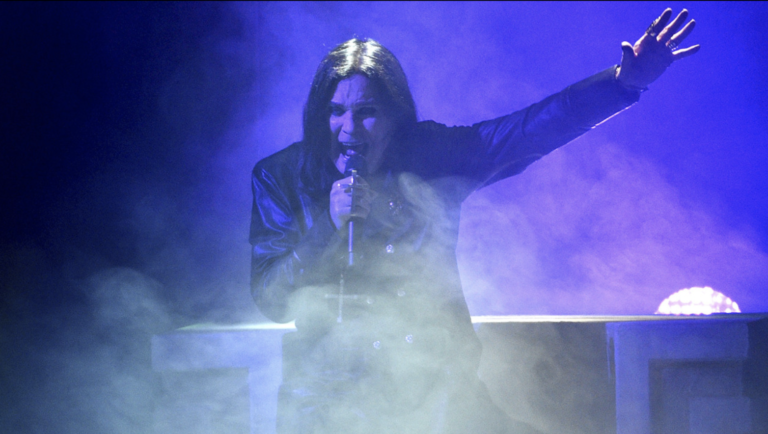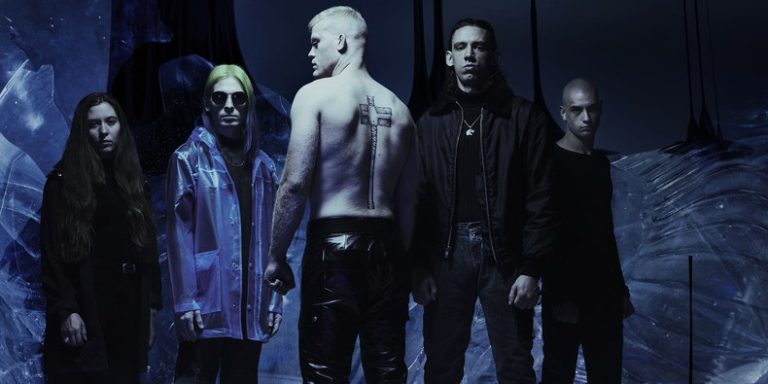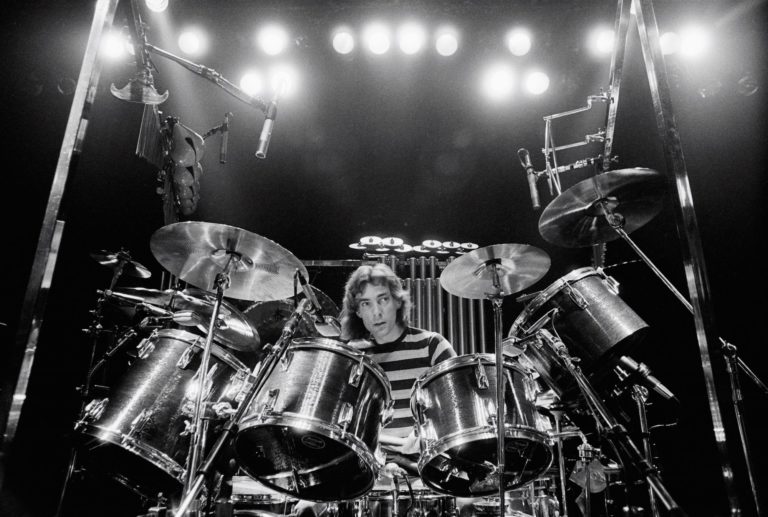HOW METALHEAD MODEL MELANIE GAYDOS IS FIGHTING TO REDEFINE BEAUTY
It was the week before Christmas in 2011 and Berlin was in a deep freeze, with temperatures hitting negative four degrees. Melanie Gaydos, an inexperienced young model with a striking, unique look, was posing outside a “very cold” abandoned sanatorium at her very first big shoot: a music video for German industrial-metal juggernaut Rammstein, directed by famed Spanish fashion photographer Eugenio Recuenco.
Gaydos was a big fan of both, having discovered Rammstein and Recuenco almost simultaneously when she was 11 or 12. A lonely art student at New York City’s Pratt Institute, she had just started dabbling in modeling a few months before, and she had written “basically a fan letter” to Recuenco, gushing about how much she’d love to work with him. She hadn’t expected a reply, yet alone one that offered to fly her out to Berlin to appear in a video for one of her favorite bands. She’d never even been on a plane before. “That [was] my first plane ride, my first trip to Europe and I was alone. It was a really amazing experience. I swear I discovered Eugenio at the same time that I discovered Rammstein. And it was really a turning point,” she says today, sitting in a New Jersey diner, reflecting on her middle-school years. “I think that was really when I started to develop my individuality as a young person.”
Heavy-metal music like Rammstein’s and visual art like Recuenco’s “dark but super-refined and beautiful” photography helped Gaydos find herself as a kid growing up in “super-suburban” Trumbell, Connecticut. In “Abercrombie Land,” as she calls it, where everyone was preppy and, at least outwardly, perfect, Gaydos didn’t fit in. She wasn’t “perfect.” Now 30, she was born with ectodermal dysplasia, an umbrella term for a number of genetic conditions affecting the development of her skin, sweat glands, hair, nails and teeth. Even relative to others with ectodermal dysplasia, her array of symptoms is unique and her case “more severe,” she says. “I was literally like an alien growing up.”
But she was also strong-headed. And before she even knew what punk and metal were, she was “super punk rock” in her IDGAF attitude. That spirit has driven her to succeed in an admittedly against-the-odds career in modeling that’s seen her work around the world, walk in multiple New York Fashion Week shows and appear in major avant-garde publications, as well as collaborate with more rock & roll figures such as Rammstein, Behemoth, Kat Von D and designer Ashley Rose. Conversely, modeling has become her platform from which to express her outlook on the world and to try to change that world: “I’m just a human, as we all are,” she says. She speaks softly but with animation, her hands in constant motion. “I think it’s pretty disgusting when people think of it as being otherwise. My main goal right now is to help the world see that just because somebody’s different, doesn’t mean that they’re not human.”

Gaydos as “Death” in Sylwia Makris’ “Tarot” photo series, 2018photograph by Sylwia Makris
Gaydos wasn’t always made to feel that way growing up. “In elementary school, I definitely didn’t have any friends,” she admits. People looked at her like she was weird, scary, inhuman. It didn’t help that she was in the hospital so much — she had over 30 surgeries as a kid — and missed a lot of school as a result. Today, she’s legally blind due to her eyelashes growing inward and scratching her corneas. She has issues with her hearing due the tininess of the bones in her ears. She has no teeth or hair. She used to wear wigs, but in 2015 she gave them up and she doesn’t use dentures, either — instead, she’s chosen to fully embrace who she is. “This is the way I was born, and when you are born a certain way, you survive,” she explains. “You just adjust. … Other people can’t imagine what eating is like without any teeth, and I’m like, ‘Bitch, it’s not so hard.'” She laughs over her pancakes with strawberry compote.
This defiant, can-do attitude really began to take shape during Gaydos’ middle-school years. An artistic child whose father taught her to draw realistic faces when she was four and who made her own dolls and sewed their “tea party dresses,” she fell in love with music as a tween, after her older brother introduced her to heavier rock bands — Rammstein, System of a Down, Slipknot. For Gaydos, the music “was really therapeutic,” she says, “because I had a bad childhood and I really wasn’t accepted in society in general, and I never understood why. There was no reason for any of the pains that other people inflicted on me. … Music gave me the strength to know that I can survive this and there is more to life than [the] present situation. Things don’t have to be a certain way, and we have the strength and power to change things.”

Gaydos wearing Ashley Rose Couture, 2017photograph by Karen Jerzyk
Through music, she started dressing “more how I wanted to” and gravitated toward “a goth circle” of fellow outsiders. It wasn’t until high school, though, that she made friendships that felt real and would last. “All of my friends had really similar music tastes and style,” she recalls. “This is also when Hot Topic was really cool — no offense to Hot Topic now.”
In “Abercrombie Land,” Gaydos expressed herself in large part through her fashion choices. An “Anti-crombie” T-shirt. Anarchy signs all over her clothes. Big, pink UFO pants. “It was really fun. I really celebrated rebellion,” she enthuses, though she adds of the UFOs with an affectionate laugh, “I can’t wear them now.” Pink raver pants might be banned from her wardrobe, but today Gaydos is rocking a long, black puffer coat lined ostentatiously with pink faux fur.

“Gold” from Karen Jerzyk’s “Chromaproscenium” photo series, 2017photograph by Karen Jerzyk
In high school, she had found a group of friends and a rebellious identity; at Pratt, before she started modeling, Gaydos found herself isolated and unhappy. “I was just really miserable. I had gotten out of a bad relationship. I was also kicked out of my house,” she reveals, though she doesn’t want to go into the details. “All of my ties to the world were severed and I was just really alone.” To some extent, her isolation was self-imposed as she rarely left her room: “I had this small, wood-paneled room with only one window. That sounds terrible, but trust me, I loved it. I was very happy in my hole. But I was not happy when I left, and that’s no way to live. I knew that if I really wanted to be happy in life, then I really had to face my fears.”
The nudge she needed came when a photographer she was dating suggested that she try modeling. “You have a really unique look, you could make a lot of money with it,” he told her. A poor art student in need of funds, she tried modeling, and surprisingly, for someone who had never liked having her picture taken — it took. “I realized, growing up, as much as I [would] talk about non-conforming with the way that I dressed and the music that I listened to, I still felt like an outsider even with people that I had things in common with,” she reflects.
“I think, in some way, I was only trying to be accepted by others,” Gaydos adds. “Then around the time I started modeling, I really was just like, ‘Fuck you!’ Why am I trying so hard to be liked by other people?”

“Appearance of Saint Peter to Saint Peter Nolasco” from “Thou Art Darkest” featuring Behemoth’s Adam Nergal Darski, 2018photograph by Sylwia Makris
The attitude shift worked wonders. For four or five months, she started booking gigs, all of them by herself through sites like Craigslist and ModelMayhem, and driven by her artistic desire to create shit that she found cool and exciting, she began to send unsolicited emails to designers and photographers whose work inspired her. One of them was Eugenio Recuenco.
At the resulting Rammstein video shoot — for the song “Mein Herz Brennt” — Gaydos found the creative collaboration she craved. Star-struck as she was, the band members immediately accepted her as a peer: “I felt really respected by them,” she says, adding that she and singer Till Lindemann are still good friends and talk on WhatsApp every few weeks. The band encouraged her to interpret her character and improvise her movements in the video, and she was even asked to sing; her brief but haunting vocals appear at the end of the Recuenco-directed “alternate” version. (Director Zoran Bihać’s version served as the official video.) “A lot of people don’t know that, but they asked me to do that on the last day,” she reveals. “They were like, ‘Melanie, we want you to sing.’ And I was like, ‘What?!'”
According to Gaydos, working with Rammstein right out of the gates jumpstarted her modeling career in the band’s homeland, and is why, to this day, she mostly works out of Berlin, returning to the U.S. in between work visas. But Gaydos has also done plenty of modeling in other European countries, including Poland, where, last year, she shot Behemoth‘s “God = Dog” video and the black-metal band’s I Loved You at Your Darkest record packaging. Polish photographer Sylwia Makris — who had worked with Gaydos for her “Old Masters” project, which recreated old masters’ paintings and caught the eye of Behemoth main man Adam Nergal Darski — was the model’s connection to the project. Once she met Nergal and the two hit it off, she ended up becoming the “muse” for the artwork and video, eventually serving as the female lead in Behemoth’s traveling “Thou Art Darkest” album-tie-in art show. “I have sooo much respect for her … She was a leitmotif, so to say … a muse maybe is a better word,” Nergal says today. “It requires a pair of big balls to turn one’s condition into art! And she did it and she’s a star in my eyes.”
“Muse” is a word that often comes up in regard to Gaydos. Metal-friendly haute couture designer Ashley Rose — who has collaborated with Chelsea Wolfe, Converge, Baroness, Deafheaven and other heavy-music artists — has referred to the model as her muse and works with her frequently, dressing her in twisted-fairytale clothing crafted with organic materials. (Gaydos calls Rose “a visionary.”) In 2018, tattoo artist Kat Von D celebrated the 10th anniversary of her makeup line Kat Von D Beauty with a “Muses” campaign, which featured Gaydos as one of its 10 muses and included the release of a limited-edition eyeshadow palette with a rosy cream eyeshadow named after her.
As proud as Gaydos is of all these collaborations within and adjacent to the rock world, she’s leery of being pigeonholed as an “alternative” model. It’s one reason why, despite making more money working in horror movies than in fashion early in her career, she has pulled back from horror. (Now she’ll do only “maybe one or two films a year.”) She wants to change attitudes in the world at large, not just capitalize on the existing inclinations of a few subcultures. “Within horror and metal, a lot of it is fantasy-based. I am hired because I fit a certain fantasy,” Gaydos acknowledges. “I was told by one male photographer, ‘It’s really cool because you have the body of a goddess but the face of a monster.’ And I was like, ‘What the fuuuck?'”

“Judith With the Head of Holofernes” from “Thou Art Darkest” featuring Behemoth’s Inferno, 2018;photograph by Sylwia Makris
For better or worse, horror and heavy metal are obvious and potentially profitable arenas for Gaydos to specialize in, but her life thus far has not been easy, and she’s not about to pass up a fight now. “Now that I am modeling and a part of the beauty and fashion industry, I feel like I have to keep going. I realize more my own personal quest,” she says. She’s been told before, “You will never walk runways. You’re never going to be in the fashion industry.” It didn’t stop her then, and now she has a cause compelling her to push onward. “I really want to normalize people that are different,” she says.
Gaydos sees things getting better. The fashion industry’s definition of beauty continues to expand beyond “the tall, perfect goddess” look, as does the mainstream world’s. Soon she’ll return to Berlin to do more modeling work, putting herself out there as a brazen artistic challenge to entrenched preconceptions and knee-jerk reactions, and as a role model to people who have faced similar hardship.

photograph by Sylwia Makris
“I truly think that when you just are yourself, you can really be an example for other people who are struggling,” Gaydos says with a smile. “You are the change that you want to see in the world — it’s just a matter of actually doing it. We’re all in this together and everybody’s kind of all going through their own thing. I think when you start making active change within yourself, within your relation to other people, that’s when things really come together.”




